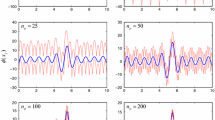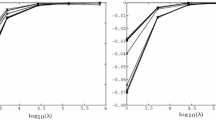Abstract
This paper describes some techniques to improve the speed of the implicit enumeration method for solving zero-one integer programming problems. Among these techniques, the most powerful is the one of using a column vector which works as a tag for each inequality, indicating whether or not the inequality should be checked for the current partial solution. A new condition for underlining a variable and the concept of pseudo-underlining are also proposed. These techniques were implemented in the computer programil lip (ILLinois Integer Programming code). The computational results for different types of problems are discussed.
Similar content being viewed by others
References
E. Balas, “An additive algorithm for solving linear programming with zero-one variables,”Operations Res. 13(4):517–544 (1965).
E. Balas, “Discrete programming by the filter method,”Operations Res. 15(5):915–955 (1967).
M. L. Balinski, “Integer programming; methods, uses, computation,”Management Sci. 12:253–313 (1965).
C. R. Baugh, T. Ibaraki, and S. Muroga, “Computational experience in all-integer, binary variable, integer programming problems using Gomory's all-integer algorithm,” Report No. 259, Department of Computer Science, University of Illinois, April 1968.
C. R. Baugh, T. Ibaraki, T. K. Liu, and S. Muroga, “Optimum network design using NOR and NOR-AND gates by integer programming,” Report No. 293, Department of Computer Science, University of Illinois, January 1969.
M. Bellmore and G. L. Nemhauser, “The traveling salesman problem: A survey,”Operations Res. 16(3):548–558 (1968).
A. Cobham, R. Fridshal, and J. H. North, “An application of linear programming to the minimization of Boolean functions,”Proceedings of the Second Annual Symposium of Switching Circuit Theory and Logical Design, 1961, pp. 3–9.
B. Fleischmann, “Computational experience with the algorithm of Balas,”Operations Res. 15(1):153–155 (1967).
R. J. Freeman, “Computational experience with a ‘Balasian’ integer programming algorithm,”Operations Res. 14(5):935–942 (1966).
A. M. Geoffrion, “Integer programming by implicit enumeration and Balas' method,”SIAM Rev. 9(2):178–190 (1967).
A. M. Geoffrion, “An improved implicit enumeration approach for integer programming,” The RAND Corporation, Memorandum, RM-5644-PR, June 1968; alsoOperations Res. 17:437–454 (1969).
F. Glover, “A multiple phase-dual algorithm for the zero-one integer programming problem,”Operations Res. 13(6):879–919 (1965).
F. Glover, “Surrogate constraints,”Operations Res. 16(4):741–749 (1968).
R. E. Gomory, “An all-integer integer programming algorithm,” inIndustrial Scheduling, J. R. Muth and G. L. Thompson, eds. (Prentice-Hall, Englewood Cliffs, N.J., 1963).
J. Haldi, “25 integer programming test problems,” Working Paper no. 43, Graduate School of Business, Stanford University, December 1964.
L. Hellerman, “A catalog of three variable OR-invert and AND-invert logical circuits,”IEEETEC EC-12(3):198–223 (1963).
T. Ibaraki, T. K. Liu, C. R. Baugh, and S. Muroga, “An implicit enumeration program for zero-one integer programming,” Report no. 305, Department of Computer Science, University of Illinois, January 1969.
P. L. Ivănescu and S. Rudeanu, “Pseudo-Boolean methods for bivalent programming,” inLecture Notes in Mathematics, Vol. 23 (Springer-Verlag, Berlin-Heidelberg-New York, 1966); alsoOperations Res. 17:233–261 (1969).
E. L. Lawler and D. E. Wood, “Branch-and-bound methods: A survey,”Operations Res. 14(4):699–719 (1966).
C. E. Lemke and K. Spielberg, “Direct search algorithm for zero-one and mixed-integer programming,”Operations Res. 15(5):892–914 (1967).
T. K. Liu, “A code for zero-one integer linear programming by implicit enumeration,” Master's thesis, Department of Computer Science, University of Illinois, December 1968.
E. J. McCluskey,Introduction to the Theory of Switching Circuits (McGraw-Hill, New York, 1965).
S. Muroga and T. Ibaraki, “Logical design of an optimum network by integer linear programming—Part I,” Report no. 264, Department of Computer Science, University of Illinois, July 1968.
S. Muroga and T. Ibaraki, “Logical design of an optimum network by integer linear programming—Part II,” Report no. 289, Department of Computer Science, University of Illinois, December 1968.
C. C. Peterson, “Computational experience with variants of the Balas algorithm applied to the selection of R and D projects,”Management Sci. 13(9):736–750 (1967).
D. Shapiro, “Algorithms for the solution of the optimal cost traveling salesman problem,” Sc. D. Thesis, Washington University, St. Louis, January 1966.
S. Woiler, “Implicit enumeration algorithms for discrete optimization problems,” Report no. 4, Department of Industrial Engineering, Stanford University, May 1967.
S. Zionts, “Implicit enumeration using bounds on variables: A generalization of Balas' additive algorithm for solving linear programs with zero-one variables,” Working Paper no. 7, School of Business Administration, State University of New York at Buffalo, Buffalo, New York, June 1968.
Author information
Authors and Affiliations
Additional information
This work is partly supported by NSF Grant No. GJ-503.
Rights and permissions
About this article
Cite this article
Ibaraki, T., Liu, T.K., Baugh, C.R. et al. An implicit enumeration program for zero-one integer programming. International Journal of Computer and Information Sciences 1, 75–92 (1972). https://doi.org/10.1007/BF01108520
Received:
Issue Date:
DOI: https://doi.org/10.1007/BF01108520




